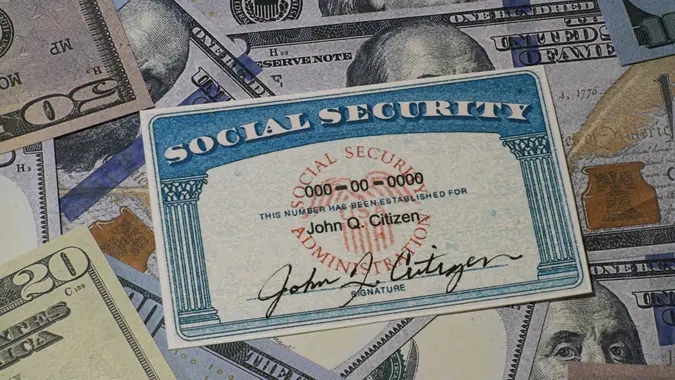How to Prepare for Relocating in Retirement

Commitment to Our Readers
GOBankingRates' editorial team is committed to bringing you unbiased reviews and information. We use data-driven methodologies to evaluate financial products and services - our reviews and ratings are not influenced by advertisers. You can read more about our editorial guidelines and our products and services review methodology.

20 Years
Helping You Live Richer

Reviewed
by Experts

Trusted by
Millions of Readers
Relocating in retirement can open the door to lower living costs, better weather or more time with loved ones. But a big move also brings big decisions and plenty of logistics. A clear moving checklist for retirees helps you stay organized, avoid costly mistakes and make the transition smoother.
This guide walks you through every step, from deciding why you’re moving to creating a timeline and settling into your new community.
Moving Timeline and Checklist for Retirees
| Timeline | Key Tasks | Why It Matters |
|---|---|---|
| 3 to 6 Months Before | • Research new locations and housing options • Hire movers or compare DIY options • Start decluttering and downsizing |
Gives you plenty of time to compare costs and avoid last-minute stress. |
| 1 to 2 Months Before | • Confirm moving date • Change mailing address with USPS and update bills • Transfer or cancel utilities |
Ensures a smooth transition with no service gaps or missed mail. |
| 1 to 2 Weeks Before | • Pack essentials like medications and important documents • Prepare travel arrangements |
Keeps you organized and ensures you’ll have everything you need on hand. |
| Moving Day | • Supervise movers • Keep valuables and documents with you • Do a final walkthrough of your old home |
Protects your belongings and helps you leave the old property in good order. |
Decide Why You’re Moving in Retirement
Many retirees move to:
- Cut costs: Downsizing or moving to a state with lower housing and tax bills.
- Be closer to family: Prioritizing grandchildren and support networks.
- Improve lifestyle: Choosing warmer climates, access to outdoor activities or cultural opportunities.
- Address healthcare needs: Proximity to hospitals and specialists becomes more important with age.
According to the Pew Research Center, nearly 40% of Americans over 65 move primarily to be closer to family or access better healthcare options. Your “why” will shape your “where.” For example, if affordable healthcare is your top concern, look at states with strong Medicare Advantage participation or lower healthcare costs.
Research Your New Location
Before packing boxes, do your homework:
- Compare costs of living: Housing, groceries, utilities and healthcare vary widely. The Bureau of Economic Analysis reports that housing accounts for 33% of retirement spending on average, making it the biggest factor.
- Check healthcare access: Medicare.gov offers state-by-state data on provider networks and plan costs.
- Test drive the area: Spend a week in your potential new town to see if it feels like home.
According to the U.S. Census Bureau, more than 1 in 5 retirees move to a different state after leaving full-time work.
Evaluate Financial Readiness for the Move
Moving isn’t just about location; it’s about affordability.
- Retirement income check: Add up Social Security, pensions, annuities and investment withdrawals.
- Budget for moving expenses: On average, a long-distance move costs $4,000 to $9,000, depending on distance and services, per Moving.org.
- Review taxes: Some states have no income tax, while others tax pensions or Social Security benefits.
Social Security replaces only about 37% of pre-retirement income for average earners, so planning other income streams is essential.
Downsize and Declutter Before Moving
Less stuff = lower costs and less stress.
- Sort items into keep, sell, donate or discard.
- Sell furniture, electronics or collectibles online. Proceeds can offset moving costs.
- Donate to local charities or give family heirlooms to children or grandchildren.
According to the National Association of Professional Organizers, the average household has over 300,000 items. Downsizing by even 20% can make a move much cheaper.
Moving Checklist for Retirees
| Timeframe | Key Tasks | Why It Matters |
|---|---|---|
| 3 to 6 months before | Research locations, create a budget | Avoid surprises and overspending |
| 1 to 2 months before | Hire movers, change address, transfer bills | Ensure a smooth transition |
| 1 to 2 weeks before | Pack essentials, organize important papers | Prevent last-minute stress |
| Move day | Supervise movers, secure valuables | Protect belongings and peace of mind |
Settling In: Adjusting After the Move
- Join community centers, clubs or senior groups to meet new people.
- Explore local volunteer opportunities to build purpose and routine.
- Find new doctors and update your Medicare plan if needed.
- Set up a new budget to reflect your updated cost of living.
Research from the CDC shows that retirees who stay socially active reduce their risk of cognitive decline by up to 40%.
Final Take to GO: Moving in Retirement Can Be Stress-Free with the Right Plan
Relocating later in life can be exciting, but it requires planning. A moving checklist for retirees helps ensure you’ve covered financial prep, downsizing and all the moving-day details.
By taking a step-by-step approach, you’ll spend less time worrying about logistics and more time enjoying your new chapter. If you’re still weighing your options, revisit your retirement budget and consult a financial advisor to make sure your move supports both your lifestyle and long-term security.
FAQs
Here are the answers to some of the most frequently asked questions about moving in retirement and how it works:- How do I choose the best place to retire and move?
- Start by prioritizing what matters most: cost of living, healthcare, family proximity or climate. Then, research states or towns that meet those needs.
- What are the biggest moving expenses for retirees?
- Long-distance movers, deposits for utilities, travel costs and furnishing a new place. Average long-distance moves run $4,000 to $9,000.
- Should I buy or rent after relocating in retirement?
- If flexibility matters, renting may be better. If stability and equity are goals, buying makes sense. Run the numbers before deciding.
- How do taxes change when I move to another state?
- Some states tax retirement income, while others don’t. Check state tax laws before moving.
- What’s the best way to downsize for retirement moves?
- Start early, sort items into categories and consider selling, donating, or gifting to family to reduce moving costs and clutter.
Data is accurate as of Sept. 8, 2025, and is subject to change.
Our in-house research team and on-site financial experts work together to create content that’s accurate, impartial, and up to date. We fact-check every single statistic, quote and fact using trusted primary resources to make sure the information we provide is correct. You can learn more about GOBankingRates’ processes and standards in our editorial policy.
- NIH.gov "Healthcare on the brink: navigating the challenges of an aging society in the United States"
- The Urban Institute "Understanding Expenditure Patterns in Retirement "
- AARP "Top 10 States Where Americans Are Moving for Retirement"
- Move.org "A Guide to Moving Costs in 2025"
- U.S. Social Security Administration "Fact Sheet For Workers Ages 18-48"
- The Los Angeles Times "For many people, gathering possessions is just the stuff of life"
- CDC "Physical Activity Benefits for Adults 65 or Older"
 Written by
Written by  Edited by
Edited by 

























